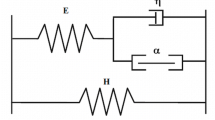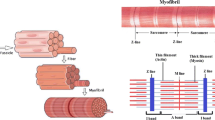Abstract
A mathematical model of contracting skeletal muscle is studied. The model is composed by an elastic element (SE) in series with a contractile element (CE) that describes the cross bridge kinetics with a formulation derived by that proposed by Eisenberg and Hill (1978).
An analytical study of the system of nonlinear partial differential equations of the model allows the existence and the uniqueness of the solution to be proved.
A suitable approach to the numerical solution is defined and a series of numerical tests are performed. These tests lead to select an appropriate set of parameters and allow to compare model predictions and experimental observations on frog skeletal muscle.
Similar content being viewed by others
References
Bagshaw, C. R., Trentham, D.R.: The reversibility of ATP cleavage by myosin. Biochem. J. 133, 323–328 (1973)
Blinks, J. R., Rudel, R., Taylor, S. R.: Calcium transients in isolated amphibian skeletal muscle fibers: detection with aequorin. J. Physiol. 277, 291–323 (1978)
Browder, F.: Problèmes non lineaires. Lectures Notes University of Montreal 1966
Chock, S. P., Chock, P. B., Eisenberg, E.: Pre-steady-state kinetic evidence for a cyclic interaction of myosin subfragment one with actin during the hydrolysis of ATP. Biochemistry 15, 3244–3253 (1976)
Civan, M. M., Podolsky, R. J.: Contraction kinetics of striated muscle fibres following quick changes in load. J. Physiol. 184, 511–534 (1966)
Close, R. I.: The relations between sarcomere length and characteristics of isometric twitch contractions of frog sartorius muscle. J. Physiol. 220, 745–762 (1972)
Comincioli, V., Torelli, A.: Mathematical aspects of the cross bridge mechanism in muscle contraction. Nonlinear Analysis, Theory, Methods and Applications. 7, 661–683 (1983)
Coray, A., Fry, C. H., Hess, P., McGuigan, J. A. S., Weingart, R.: Resting calcium in sheep cardiac tissue and in frog skeletal muscle measured with ion-selective micro-electrodes. J. Physiol. 305, 60P (1980)
Curtin, N. A., Woledge, R. C.: Energy changes and muscular contraction. Physiol. Rev. 58, 690–761 (1978)
Douglas, J., Milner, F. A.: Numerical methods for a model of cardiac muscle contraction. Calcolo XX, 123–141 (1983).
Ebashi, S., Endo, M.: Calcium ion and muscle contraction. Prog. Biophys. Mol. Biol. 18, 123–183 (1968)
Edman, K. A. P.: The velocity of unloaded shortening and its relation to sarcomere length and isometric force in vertebrate muscle fibres. J. Physiol. 291, 143–159 (1979)
Edman, K. A. P., Flitney, F. W.: Laser diffraction studies of sarcomere dynamics during “isometric” relaxation in isolate muscle fibres of the frog. J. Physiol. 329, 1–20 (1982)
Edman, K. A. P., Hwang, J. C.: The force-velocity relationship in vertebrate muscle fibres at varied tonicity of the extracellular medium. J. Physiol. 269, 255–272 (1977)
Eisenberg, E., Greene, L. E.: The relation of muscle biochemistry to muscle physiology. Ann. Rev. Physiol. 42, 293–309 (1980)
Eisenberg, E., Hill, T. L.: A cross-bridge model of muscle contraction. Prog. Biophys. Mol. Biol. 33, 55–82 (1978)
Eisenberg, E., Hill, T. L., Chen, Y. D.: Cross-bridge model of muscle contraction: quantitative analysis. Biophys. J. 29, 195–227 (1980)
Flitney, F. W., Hirst, D. G.: Cross-bridge detachment and sarcomere “give” during stretch of active frog's muscle. J. Physiol. 276, 449–465 (1978)
Ford, L. E., Huxley, A. F., Simmons, R. M.: Tension responses to sudden length change in stimulated frog muscle fibres near slack length. J. Physiol. 269, 441–515 (1977)
Hill, T. L.: Theoretical formalism for the sliding filament model of contraction of striated muscle. Part I. Prog. Biophys. Mol. Biol. 28, 267–340 (1974)
Hill, T. L.: Theoretical formalism for the sliding filament model of contraction of striated muscle. Part II. Prog. Biophys. Mol. Biol. 29, 105–159 (1975)
Huxley, A. F.: Muscle structure and theories of contraction. Prog. Biophys. Biophys. Chem. 7, 255–318 (1957)
Huxley, A. F., Simmons, R. M.: Proposed mechanism of force generation in striated muscle. Nature (London) 233, 533–538 (1971)
Huxley, A. F.: Reflections on muscle. Liverpool U.K., Liverpool University Press 1980
Johnson, J. D., Charlton, S. C., Potter, J. D.: A fluorescence stopped flow analysis of Ca2+ exchange with troponin C. J. Biol. Chem. 254, 3497–3502 (1979)
Julian, F. J., Sollins, K. R., Sollins, M. R.: A model for the transient and steady-state mechanical behaviour of contracting muscle. Biophys. J. 14, 546–562 (1974)
Lymn, R. W., Taylor, E. W.: Mechanism of adenosine triphosphate hydrolysis by actomyosin. Biochemistry 10, 4617–4624 (1971)
Podolsky, R. J., Nolan, A. C., Zavaler, S. A.: Cross-bridge properties derived from muscle isotonic velocity transients. Proc. Natl. Acad. Sci. USA 64, 504–511 (1969)
Pollack, G. H.: The cross-bridge theory. Physiol. Rev. 63, 1049–1113 (1983)
Rall, J. A.: Effects of temperature on tension, tension-dependent heat, and activation heat in twitches of frog skeletal muscle. J. Physiol. 291, 265–275 (1979).
Robertson, S. P., Johnson, J. D., Potter, J. D.: The time-course of Ca2+ exchange with calmodulin, troponin, parvalbumin and myosin in response to transient increases in Ca2+. Biophys. J. 34, 559–569 (1981)
Smart, D. R.: Fixed Points Theorems. Cambridge: Cambridge University Press 1974
Sugi, H.: Tension changes during and after stretch in frog muscle fibres. J. Physiol. 225, 237–253 (1972)
Author information
Authors and Affiliations
Additional information
Work partially supported by M.P.I., by CNR through I.A.N. of Pavia and by HUSPI Project
Rights and permissions
About this article
Cite this article
Comincioli, V., Torelli, A., Poggesi, C. et al. A four-state cross bridge model for muscle contraction. Mathematical study and validation. J. Math. Biology 20, 277–304 (1984). https://doi.org/10.1007/BF00275989
Received:
Issue Date:
DOI: https://doi.org/10.1007/BF00275989




